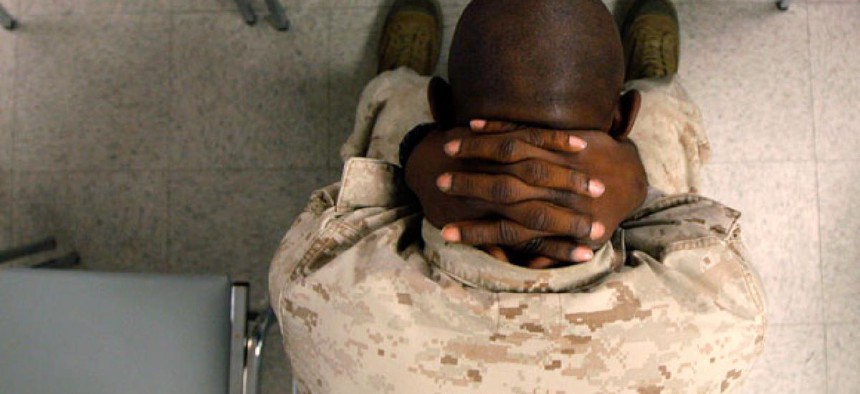Mental illness is the leading cause of hospitalization for active-duty troops

Jae C. Hong/AP
Defense and VA spent nearly $2 billion on psychotropic drugs during the past decade.
The Defense and Veterans Affairs departments have spent almost $2 billion since 2001 to buy drugs to treat mental illness and post-traumatic stress disorder despite growing evidence some of those drugs exacerbate PTSD symptoms, a Nextgov investigation shows. In addition, military research released this week highlighted that Defense faces what one Army clinician called an epidemic of mental illness.
Despite this vast expenditure on psychotropic drugs since the beginning of the wars in Afghanistan and Iraq, mental illness ranks as the leading cause of hospitalization for active-duty troops, according to a report published by the Armed Forces Health Surveillance Center in the April issue of its Medical Surveillance Monthly Report , released May 14. Mental health disorders stood out as the leading cause of hospitalization of active-duty service members in 2007, 2009 and 2011, the report noted.
AFHSC also reported that troops seeking help for mental health problems ranked third in outpatient visits in all treatment categories, behind unspecified “other” conditions -- which included routine physicals, immunizations and predeployment assessments -- and musculoskeletal injuries during the same time period.
According to the report, the military hospitalized 21,735 active-duty personnel for mental disorders in 2011, a more than 30 percent increase from 2009, when 15,339 troops needed hospital treatment for mental health problems. Hospitalizations in 2009 jumped 8 percent from the 14,112 troops hospitalized for mental health reasons in 2007.
“The crude hospitalization rate for mental disorders in the Army was approximately 70 percent higher than in the Marine Corps and more than twice as high than in the other services” in 2011, AFHSC said, noting that 13,003 soldiers were admitted to hospitals for mental health treatment that year.
The surveillance center identified 1,890,111 outpatient visits for mental disorders in 2011, or more visits than the number of troop on active duty that year -- 1,425,113 -- indicating multiple visits by individual troops. Outpatient treatment for mental health care in 2011 marked a 21 percent increase over 1,506,671 visits in 2009 and a 37 percent increase over the 946,187 mental disorder outpatient visits in 2007.
An active-duty Army doctor who declined to be identified for publication said the outpatient statistics that AFHSC compiled may be somewhat misleading because many relatively mild mental health conditions increasingly are subject to screening and identification.
But, the “stunning growth in numbers and rates of mental health hospitalizations . . . is undeniable evidence of an unprecedented and arguably unmanageable epidemic that is now threatening the viability of the force,” he wrote in an email.
Treatment Challenges
Top military leaders recently have acknowledged that some of the prescription drugs used to treat mental illness, including second-generation antipsychotic drugs , also known as atypical antipsychotics such as Seroquel and Risperidone, may be exacerbating the problem.
Dr. Jonathan Woodson, assistant secretary of Defense for health affairs, in a Feb. 22 memo on drug use, said, “articles in popular media and the concern of several national and military leaders in recent months have raised the question of whether certain psychoactive medications are inappropriately prescribed for post-traumatic stress disorder.”

Broken Warriors
is an ongoing series on mental health issues in the military.
In the memo, first reported by Army Times May 3, he noted that 1.4 percent of soldiers and 0.7 percent of Marines on active duty in 2010 -- about 11,000 troops -- received prescriptions for Seroquel. Woodson told military clinicians to use caution when prescribing atypical antipsychotics as sleep aids or to manage irritability and anger. He said military health care providers should prescribe the lowest drug dose possible and recommend “non-medication therapy options” to treat PTSD.
In April, the Army Medical Command warned that the use of benzodiazepine tranquilizers such as Xanax and Valium to treat PTSD could intensify combat stress symptoms and lead to addiction.
Seven months earlier, in September 2011, the Defense Centers of Excellence for Psychological Health and Traumatic Brain Injury emphatically warned against their use. In its Co-Occurring Conditions Toolkit , the center said in boldface, “ There is evidence against the use of benzodiazepines in PTSD management as it may cause HARM. Strongly recommend against the use of benzodiazepines for treatment of PTSD. ”
The Defense center also recommended against the use of Seroquel and another atypical antipsychotic to treat PTSD saying, in boldface, “ evidence does NOT support the use of atypical antipsychotics as a monotherapy for PTSD .”
Data provided to Nextgov by the Defense Logistics Agency shows the Defense Department spent $44.1 million on benzodiazepines from October 2001 to March 2012. The Veterans Affairs Department said it spent $72.1 million on benzodiazepines during the same period.
VA told Nextgov in April that it spent $846 million on Seroquel since 2001 and $717 million on Risperidone, another atypical antipsychotic, during the same period.
Defense has spent $14.1 million on Seroquel and $74 million on Risperidone since 2001.
A paper published by VA researchers in August 2011 said Risperidone was no more effective than a placebo in treating PTSD. The Army acknowledged VA’s research in its April 10 policy memo, but the February 2012 Woodson memo made no mention of Risperidone.
The Navy Bureau of Medicine and Surgery, which provides health care for Navy and Marine Corps personnel, told Nextgov in an email that the bureau “concurs with the Army's policy that benzodiazepines are relatively contraindicated and should be avoided in the treatment of PTSD.”
But Shoshona Pilip-Florea, a bureau spokeswoman, said, “there are many scenarios where the judicious prescription of benzodiazepines may be appropriate, [including] when the clinician's assessment and clinical judgment warrant treatment with this class of medications.” She added, “Navy Medicine has not explicitly warned clinicians not to use benzodiazepines to treat patients with PTSD because some of these patients may benefit from treatment with a benzodiazepine based on the clinician's assessment and clinical judgment.”
Jonathan Stock, a spokesman for the Air Force Surgeon General, said the Air Force has not prohibited providers from using benzodiazepines in cases of PTSD. “It is important to note that every medication has associated cautions and contraindications. Prescribing providers are required to understand the contraindications and precautions of the medications they prescribe,” he said.
VA and DLA did not provide details on how many individual doses of benzodiazepines they have purchased since 2001, but they receive substantial bulk discounts. The active-duty Army doctor said this could be as low as $1 dollar per pill, or a total of 116 million doses since 2001, which work out to more than 100 benzodiazepine pills per person on active duty today.
Besides a mental health epidemic, the Army clinician said the Pentagon also faces the epidemic consequences of widespread psychotropic drug use, which military researchers warned about in a 2008 report. It showed that one of 14 members of a 701-man Army infantry battalion had been prescribed anti-anxiety drugs before deployment.
NEXT STORY: A Review of Bum PTSD Diagnoses Coming Soon






